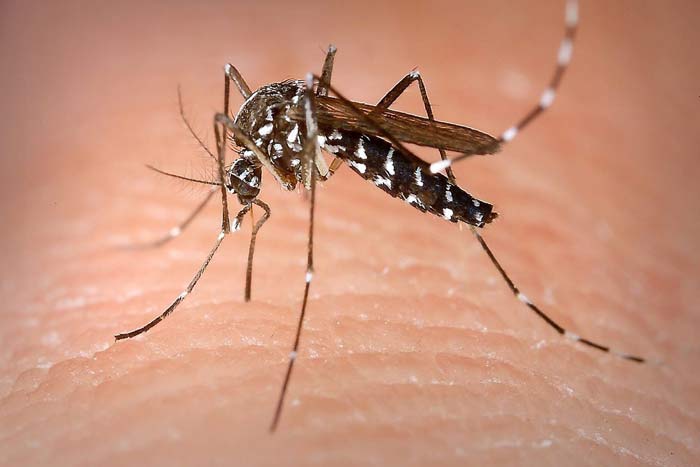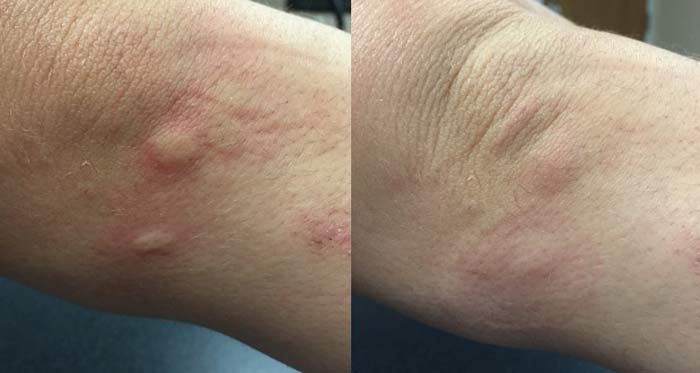

Table of Contents
Mosquito bites vs bed bug bites -How to tell the Difference
Appearance
Mosquitoes just like bed bugs are stealthy and they may bite you without your seeing. This means that you need to understand and be able to tell the difference between a mosquito and a bed bug bite. This is how a mosquito bite looks like:- After a bite, a pale or red swelling or inflammation forms. It may also occur as a white swelling with a central reddening. The bump is at first soft and hardens when scratched.
- The swelling need no necessarily form on the same day or within the next 15 minutes after being bitten. It may form a day after.
- Blisters may form in some people rather than the normal reddened inflammation.
- Dark spots may form resembling scarring or dried bruises.
- Systemic symptoms may occur when you have an over-stimulation of the immune response particularly seen in people with some immune system disorders. The area may be overly swollen with some low grade fever and a headache.
- The bites are in isolation and get swollen faster than a bed bug bite.
- The bites from a bed bug are flat and does not bear any central characteristic appearance to the swelling. The inflammation may redden but may appear as normal tinged to skin complexion in most people.
- Bed bug bites resemble welts. They appear as streaks that stretch in a multi-directional fashion but these are able to fade within the next few minutes.
- Bed bug bites occur in a line with about 4-6 bites. If these occur in total isolation, then your culprit isn’t a bed bug but a mosquito or something else.
- It may take longer for bed bug to start itching or appear. While it may take some few minutes for the reaction to appear in some people, it may take days to appear in others.
Size
The size of bed bug bites are about 4-5 mm long and 1.5-3 mm wide while bites from a mosquito depends on the time the mosquito’s labium stuck into the skin. The longer, the larger it will become.Disease Transmission
Bed bugs are not linked to any disease or pathogen even though researchers have found bed bugs to have some pathogens on their bodies. Mosquitoes are considered the most dangerous family of all arthropods as they have the potential to spread pathogens ranging from arboviruses to protozoa. Arboviruses are those viruses that are vectored by arthropods. The following are some of the diseases they can cause in human (Illinois Department of Public Health):- Malaria: female Anopheles quadrimaculatus
- West Nile Virus: Culex mosquitoes ( pipiensand C. quinquefasciatus), the western encephalitis mosquito (C. tarsalis) and Aedes albopictus
- LaCross Encephalitis: Aedes albopictus
- Eastern and Western Equine Encephalitides: Eastern is caused by Culex tarsalis while several species cause the Western type.
- Zika virus: Aedes albopictus and Aedes aegypti
- Dengue fever
- Yellow fever
- Chikungunya virus
- Filariasis
Reaction
When you are bitten by a mosquito, the bite turns red right away. They are rarely close seated but rather appear in isolation and only coincidence may render them close. Since the reaction is immediate, a rash or a raised bump appears quickly with a central white dot. While the reaction is common to everyone, there are people who get a more serious reaction to the bite with formation of blisters possible. Bed bugs bite and the time it will take for a reaction to occur depends on the individual. Reactions may range from the first 15 minutes to days after. The reaction results in red swellings, a rash or may resemble a welt. The bites appear in a line. Unlike mosquito bites, some people do not get a reaction.Identification
Check to see if you can be able to tell the whether a reaction you have on your body is a mosquito’s or a bed bug’s. You can do this by:- Checking the pattern, shape, spacing and the frequency of bites
- The color of the inflammation while taking keen interest of the center.
- The size of the bumps
- Any systemic symptoms that accompany the bite.
What and where they bite
Bed bug bite you when you are asleep or seated on your bed or other household furniture. They may bite during the day but are most prevalent in the night. They bite any part of the body as they can crawl on your body without your knowing and do not have to take advantage of body exposure as does a mosquito. They are normally attracted to the carbon dioxide you exhale and this is why they seem to appear at night. Mosquitoes can bite anywhere too. Unlike bed bugs, they bite uncovered body parts and mostly preferring the upper torso. Mosquitoes are most prevalent when you have an existing bushy compound and standing water ponds just close to your house which facilitate breeding of mosquitoes. Mosquitoes commonly bite just before dawn too and in seasons that are warmer enhancing breeding of mosquitoes. They are most prevalent in the tropics.Getting rid
In order to get rid of either mosquito or bed bug bites, you can either look out for home natural remedies that work or conventional medication to treat the itch and the inflammation. These are discussed in the following section.Treatment
Most bites from insects cause an allergic reaction and are therefore treated in the same way. This involves washing the areas bitten with some cold water and soap. Desist from using hot water as this may worsen the itch. You can also go colder with an ice pack on the area though this will have to be done for a non-diffuse reaction. There are natural home remedies that work well with inflammations and itch including peppermint, lavender and tea tree oils. You can also use some rose water. Always remember not to scratch either of the two bites as you face a risk of complicating them. Conventional treatment methods involving getting an over-the-counter medications such as anti-inflammatory corticosteroids and oral antihistamines. In the case with mosquito bites, it is not normally recommended that you take non-steroidal anti-inflammatory drugs such as ibuprofen or aspirin as they make work but mask an incumbent infection especially if a pathogen has been transmitted to you.Prevention
To prevent mosquito bites entirely may not be possible but you can at least reduce the chances of they doing so:- If you live in an area with mosquitoes, ensure that you have cleared your bush and any standing waters or pools to prevent breeding and therefore, bites.
- Use a net especially impregnated ones to prevent reach by mosquitoes.
- You can use the mosquito repellent DEET. It contains picaridin, an approved effective mosquito repellent by the CDC and further enjoying positive findings from a publication in the New England Journal of Medicinein 2002
- Use Citronella candles to draw mosquitoes away from where you sleep.
- Try eliminating them by calling on professional pest service to treat your dwelling for you.
- You can try out a variety of methods that have been shown to work such as the use of interceptors on your bed, freezing harbors of bed bugs and wrapping items with bed bugs.
- You can try pushing your bed and furniture away from the walls as bed bugs are known to crawl on walls and onto furniture and bedding while you sleep.
Pictures of Bites on Humans


Similarities
Some of the similarities between mosquito and bed bug bites include:- They both cause itchy allergic reactions
- They are both inflammations with some red on them
- The extent and severity of the inflammation is also dependent on the individual’s special responses hence varying sizes, onset time and duration of healing.
- Bites can occur anywhere on the body so long as the area is accessible.
- Bed Bug life cycle-Eggs, Baby(Nymph) to Adult Stages & Pictures
- How to Detect Bed Bugs-Detectors, Light & Verifi Reviews
- How to know if Bed Bugs are gone after Treatment & what to do
- Will Bleach Kill Bed Bugs-How does it work?
- Best Bed Bugs Traps- DIY Homemade, Co2, Yeast + Reviews
- How to Deal with Bed Bugs in your Car
- Bed Bugs in Couch-Covers, Signs & How to Get rid
- How to Kill Bed Bugs with Steam: Best Steamers & Guide + Tips
- Does Alcohol Kill Bed Bugs? Rubbing, Isopropyl & Percentage
- How Long do Bed Bug Bites Last, Take to Appear, Go Away & Heal
- Natural Predator of Bed Bugs-What Insects/Bugs eat Bed Bugs?
- Can Bed Bugs Live in TVs & Other Electronics? How to get them out
- Do Bed Bug Bites Itch or Hurt?
- Bed Bug Interceptor-How it works, DIY & Reviews
- What do Bed Bug Bites look like? Pictures & Identification Steps
- What Attracts Bed Bugs & things they Hate /Dislike Most
- Can Bed Bugs make you Sick? How are they Dangerous?
- Can Bed Bugs Fly-Do they have Wings-How Far can they Travel
- Diatomaceous Earth for Bed Bugs-How to Use & Best Reviews
- DIY Bed Bug Heat Treatment: Success Rate,Temperature Chart, Preparation & Reviews
- Does Vinegar Kill Bed Bugs? Can it be Used for Bites?
- How to Get Rid of Bed Bugs on Mattress- Best Covers, Protectors & Encasement Reviews
- Can Bed Bugs live on or Bite Dogs & Cats (Pets)?
- Bugs that look like Bed Bugs-Beetles & Others that Resemble or Mistaken
- Bed Bug Bombs-Do Foggers work? Effectiveness & Reviews
- Bed Bug Repellents -Natural Homemade, Creams, Electronic & Reviews
- How do Bed Bugs Spread? Are they Contagious? How Fast/Easily from Person, Room or House?
- Best Bed Bug Sprays-DIY Homemade, Natural, Brand Reviews
- Flea Bites vs Bed Bug Bites + Differences & Pictures
- How to Prevent Bed Bugs-Bites while Sleeping at Home, School, Hotel & Travelling
- How to get rid of Bed Bugs on Clothes-Can they Live, Bite through or Travel on Laundry
- Fumigation for Bed Bugs-Cost & Preparation
- How to get Bed Bugs out of Carpet with Cleaner & Powder
- How Long do Bed Bugs Live Without Food, Host, Air, in Cold & After Spraying
- Bed Bug Rash on Skin, Pictures, Treatment, Allergy & Symptoms
- Where do Bed Bugs Hide and how to Find them
- Mosquito Bites vs Bed Bug Bites-What’ are the differences
- Identifying Bed Bug Eggs- How they look like, Images & destruction
- How do you know if you have Bed Bugs-Symptoms & Signs
- Bed Bug vs Spider Bites- Differences with Pictures
- Bed Bug Sniffing Dogs-How they smell, Sense, Roscoe, Breeds & Cost
- What are Bed Bugs? Names in other Languages
- Where do Bed Bugs come from? Causes, how you get them & Start
- How to Kill/Get Rid of Bed Bugs Fast Yourself Naturally for Good
- Bed Bugs in Hair Symptoms, Pictures & Get rid
- Types of Bed Bugs
- Bed Bug Poop/Droppings-How it looks like, Pictures +Identification
- Bed Bug Shells, Cast Skin & Exoskeleton
- Can you See Bed Bugs with the Naked eye? Pictures, Size, Color & Anatomy
- Dust Mite vs Bed Bug Bites